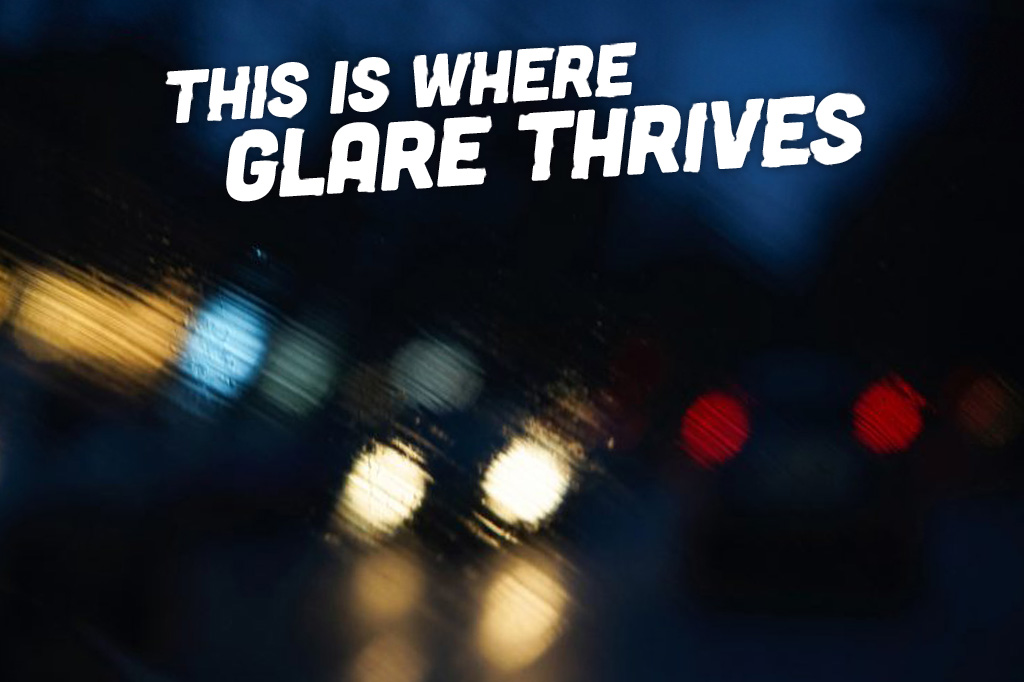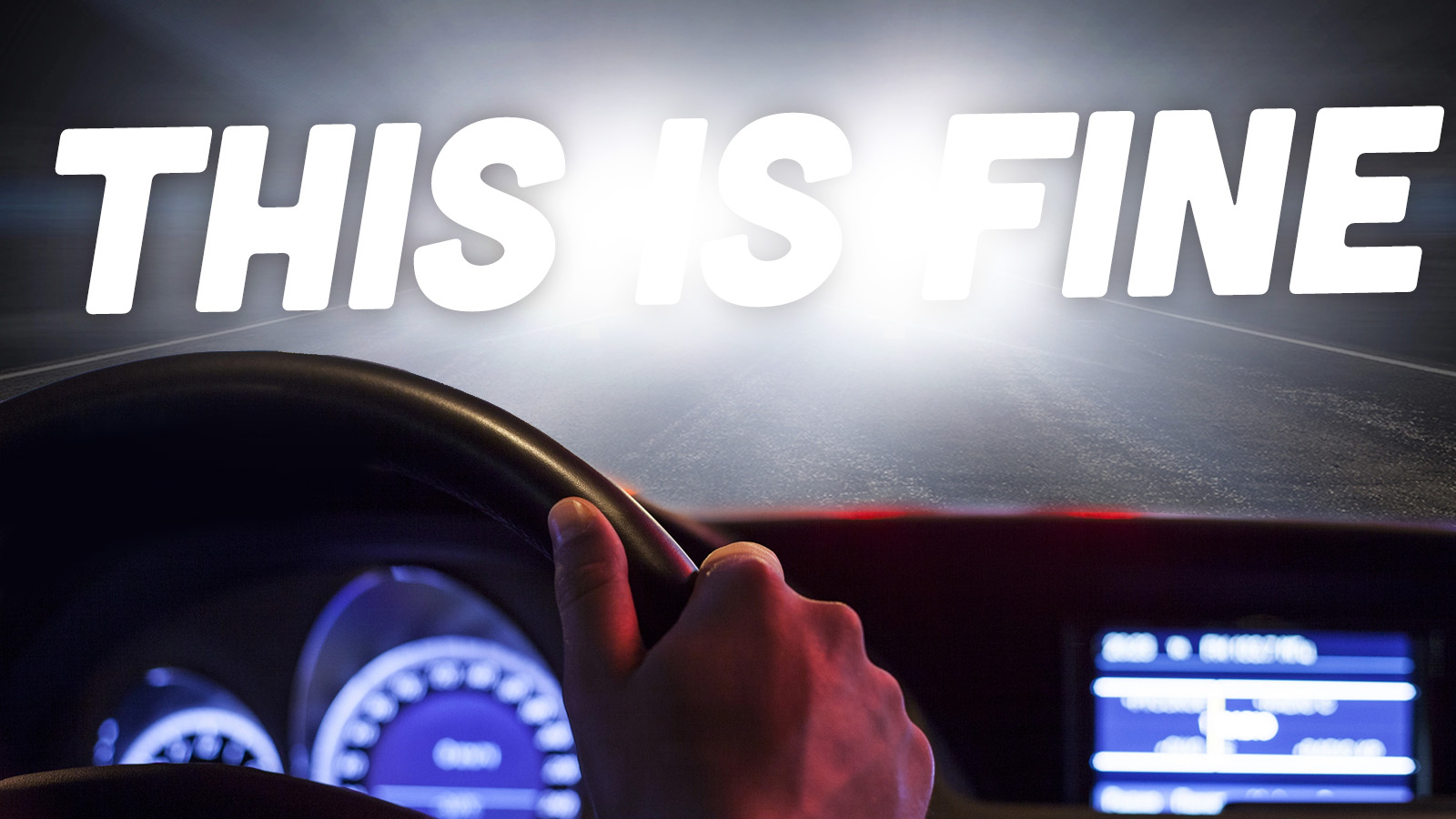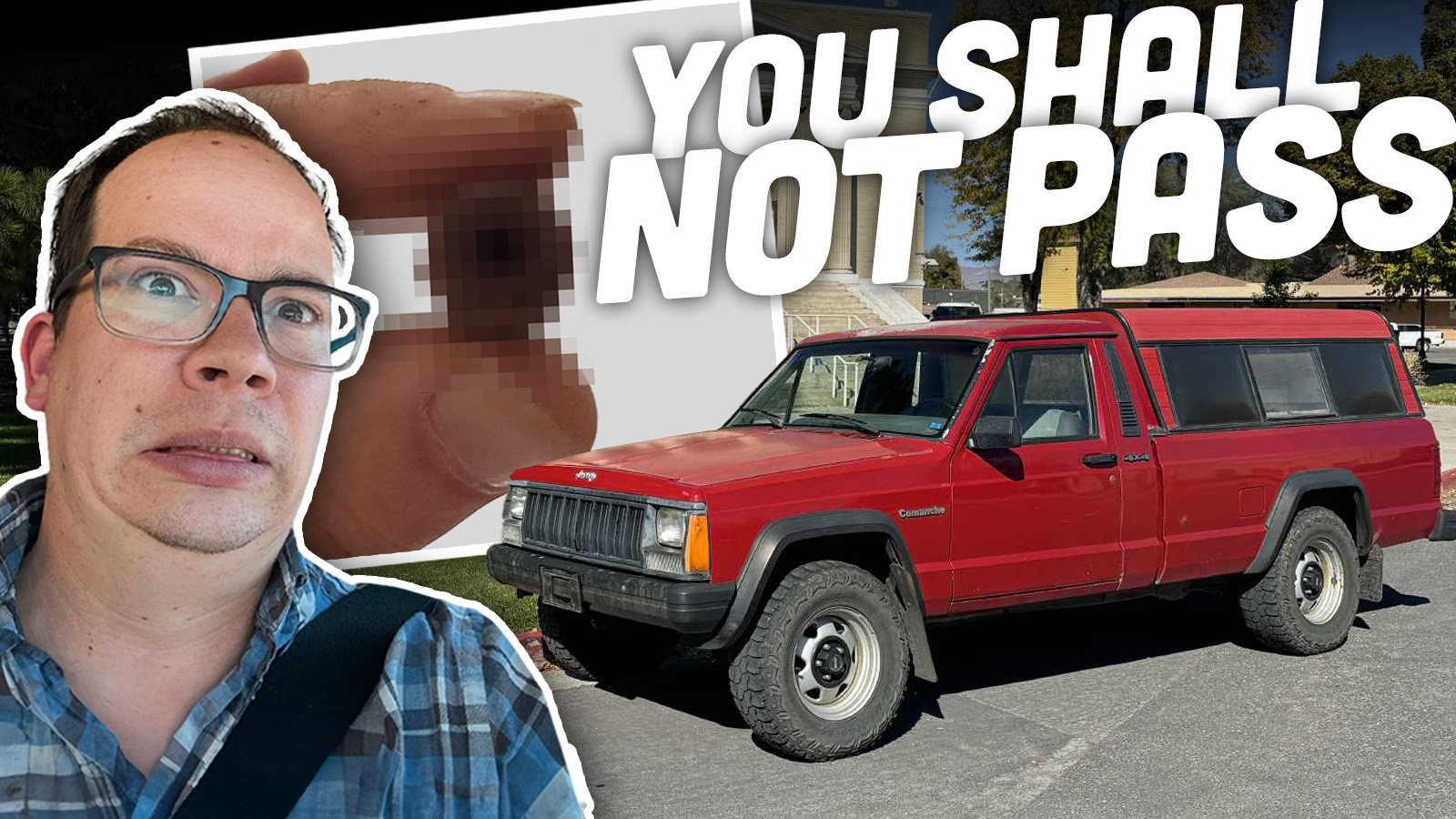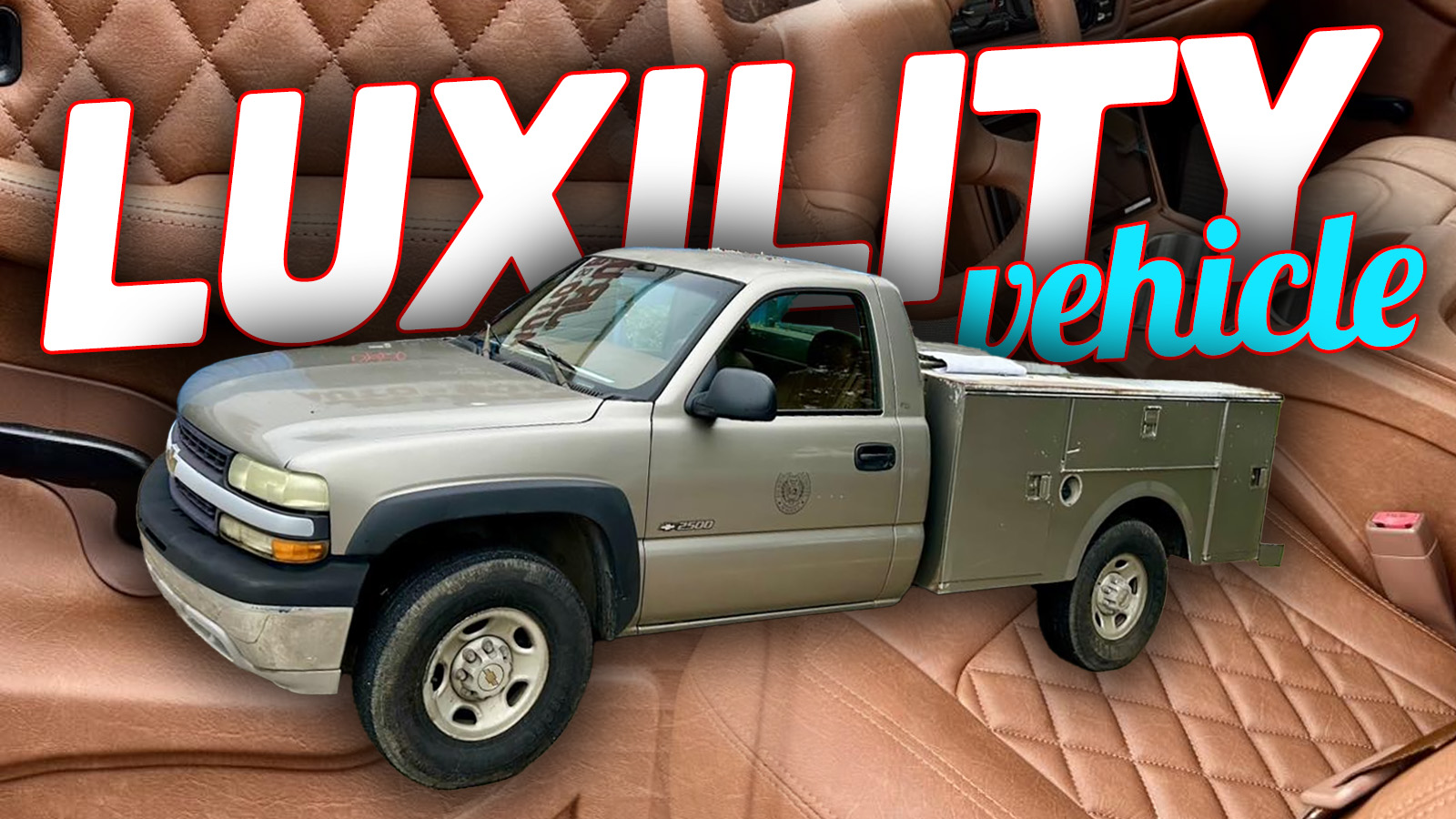As a person who often drives cars that are low to the ground, and therefore at a prime height to be blinded by oncoming and rearward traffic, I believe headlights have gotten too bright. Though I have no data to prove this, my 15 years of experience on the road have given me enough anecdotal evidence to declare it.
I’m not alone. Almost everyone I talk to in this industry has strong opinions on headlights, and most of those opinions tend to focus on how modern headlights tend to blind oncoming traffic. Surely these headlights must be responsible for a big spike in nighttime crashes, right?
The answer is no, at least, not according to the data. The Insurance Institute for Highway Safety conducted a study earlier this month to find out whether the swell of complaints regarding headlight glare actually correlated to an increase in crashes. And it didn’t find the correlation people assumed it might. From the release:
IIHS Principal Research Engineer Matthew Brumbelow examined data from 11 states in which police can list glare as a contributing factor in crash reports. Because only two of those states distinguish between glare caused by the sun and glare caused by the headlights of an oncoming vehicle, he looked specifically at crashes with glare that occurred at night.
Out of around 24 million total crashes, fewer than 150,000 had glare coded as a contributing factor, and a far smaller fraction were both coded for glare and occurred at night. With a few exceptions, these nighttime glare crashes accounted for only one or two out of a thousand crashes per year in all 11 states.
Moreover, while this glare rate ticked up and down a little, it remained relatively constant over the study period and certainly did not show a steady increase coinciding with the improvement in IIHS headlight ratings. In fact, the glare rate was highest in 2015 and lowest in 2020.
So, to those who think that headlights are so dangerously bright that manufacturers should be held accountable, consider getting into more crashes and blaming glare from oncoming motorists. This way you’ll drive the statistics in your favor (please don’t actually do this).

It’s worth noting that the federal standards for minimum and maximum headlight brightness haven’t changed since 1997. The reason you’re conceiving headlights as “brighter” is thanks to the IIHS itself, which started rating headlight effectiveness in 2016. The organization admits this move was a driving force for manufacturers to adopt LED headlights and take more care in how headlights are aimed.
These changes, as annoying as they may be for oncoming drivers, have led to considerable improvements in visibility, according to another study by the IIHS released back in 2021:
Nighttime crash rates per mile are nearly 20 percent lower for vehicles with headlights that earn a good rating in the IIHS evaluation, compared with those with poor-rated headlights, the study found. For vehicles with acceptable or marginal headlights, crash rates are 15 percent and 10 percent lower than for those with poor ratings.
“Driving at night is 3 times as risky as driving during the day,” says IIHS Senior Research Engineer Matthew Brumbelow, who conducted the study. “This is the first study to document how much headlights that provide better illumination can help.”

The IIHS says that 21% of the cars it tested produced excessive glare in 2017. That number dropped to just 3% for 2025 models. But as the complaining public—myself included—proves, there’s always room for improvement.
Glare can be disconcerting to some drivers, even at levels that don’t exceed the IIHS tolerances. Moreover, people with age-related macular degeneration and other health conditions can be especially sensitive to bright lights.
That correlates with another thing Brumbeow discovered in the study: Those who blamed crashes on glare were more likely to be older.
[D]rivers in crashes with reported glare tended to be older in age and driving older vehicles.
“Drivers older than 70 seem to be most affected by headlight glare, while those between 55 and 60 don’t appear to have an increased crash risk,” Brumbelow said.
The IIHS goes on to say that driver assistance tech, such as lane-departure warning and automatic high beams, can help to reduce issues caused by headlight glare. It also mentions an even better piece of tech as a solution to people’s headlight concerns: Adaptive drive beam headlights. These types of lights, already available on many luxury vehicles sold in Europe, were only recently made legal for use on cars sold in America. Here’s how it works, according to our own David Tracy:
These types of headlights, offered by other manufacturers like BMW and Jaguar but really popularized by Audi as the company’s “Matrix-design LED headlights,” work by cutting power to certain LED elements based on what lies ahead. As an oncoming driver approaches, instead of just shutting off the high beams, this Matrix technology just removes “pixels” of light so as not to blind the oncoming driver, thus allowing for excellent visibility ahead.
And here’s how they work, according to this nine-year-old Audi video:
So far, only Rivian has been able to implement the tech on its cars, though considering the awesome benefits these lights offer, I suspect many luxury brands will have them available next year.
Top graphic image: DepositPhotos.com








The problem is aftermarket replacement lamps. Sure, some Teslas, Subarus, and GM products made a few years ago were absolutely terrible, but it seems like most of the manufacturers are figuring it out.
It’s the beaters with the fogged over lenses that’s the worst offenders, especially when that beater is a lifted Ram 2500 and there are also bright white fog lamps and light bars running in all conditions. How about a headlight polishing kit instead of installing strobing Temu daylight intensity bulbs?
Hyundai Palisades and Kia Tellurides are the bane of my existence currently, since I drive a relatively low-to-the-ground (in comparison to the average soccer mom school bus size SUV) Mazda6. I was across an intersection for a Hyundai Palisade recently and we were both waiting for the light to turn green.
Once the Palisade arrived, I could no longer see the stoplight to tell what color it was.
Also, thank God for the 6’s auto-dimming rear view mirror.
Auto dimming mirrors are a feature I miss from my old Town Car. It was so, so nice.
Honestly I’d be interested to see how big of a difference warmer white LEDs would make on glare. Part of the issue is elevated levels of blue light causes your temporary night vision to “shut off”- it’s a bunch of fancy protein stuff in your eyes. Military aircraft have traditionally used red, sometimes green, on avionics for that very reason.
I’m also curious as to how many accidents were related to glare, but the issue was never truly cited either by the driver or whoever processed the report (police officer or insurance). Is “poor illumination” a listed cause of accident?
Also I’m two days late, but here’s the opposite perspective: https://www.theringer.com/2024/12/03/tech/headlight-brightness-cars-accidents
It touches on how automakers and the IIHS have incentives to ignore the issue of too much brightness
Just drive with closed eyes, problem solved
Clearly my defective eyeballs and less-than-spotless glass are the only things to blame for me being blinded briefly when encountering searing blue-white headlights at night. Wow, I never considered that, thanks IIHS. 😛
(Interestingly, the worst offenders I encounter are cars. I couldn’t begin to tell you what model, because I can’t make out the shape of the vehicle. Some are obviously aftermarket modifications given the horrible flicker. The worst trucks I encounter are the ones with off-road lightbars running full time.)
Newer trucks (of all makes) and Infiniti SUV’s are the bane of my existence.
♫ Blinded by the light
wrecked up my sweet duce
crash in the middle of the night ♫
I ran right down to the comments, so apologies if this was addressed above, but with an over $8,000. cost to replace a single Audi laser headlamp assembly, I think they ought to rethink light-related stuff in general.
I had one Audi, and liked it, but it was unreliable and hard to fix. They still make some reasonably appealing cars, but I’ll be damned if I’m going to voluntarily subject myself to that kind of ownership experience.
You have hit on one of my big driving pet peeves. I live in an area with a lot of large pickups and SUVs. I drive a normal car, ergo, getting blinded by oncoming headlights is not an infrequent occurrence for me. I also live in Canada where in the middle of winter it’s dark at 4pm.
The previous owner of my VFR800 put an 8000K HID kit into the headlights. I’ve never bothered to replace it, because it lights up THE WORLD…but I know I’m 100% blinding drivers with its unfocused photons. I tell myself that it’s better than not being seen…
Most of the problem is NOT with unmodified cars. It s BLUESTAR by Sylvania and the ilk that are the criminals!
Zombie, zombie, zombie-ie-ie
“So far, only Rivian has been able to implement the tech on its cars…”
I believe Tesla has also turned on matrix functionality, possible only in the refreshed 3 and Y. I wish the Germans would activate this lighting tech instead of disabling it and marketing it as “Matrix-design” :/
My 2023 and 2026 Model Ys both have matrix headlights.
Also blasphemous to say, I have a tinted windshield that seems to help.
IIHS: “we have investigated ourselves and found no wrongdoing”
The article points out how IIHS is driving brighter headlights, so of course they would deny that brighter headlights could cause any issue
It seems like the problem has gotten better over the last few years, so it’s not me it’s the vehicles. 90% of oncoming vehicles are fine, 10% are blinding.
The C-shaped DRLs on the Ford superduty pickups were among the worst offenders, apparently they were staying on full bright at night but that was supposed to be fixed by a recall. Most have been, but I still see one occasionally. Today most oncoming vehicle headlights are tolerable except for the occasional asshat that doesn’t dim their lights.
Admittedly, I’m an older driver, but Ford pickup trucks (especially the 250s) had the most annoying (low beam) headlights when I lived in Texas and had to drive on a two-lane road at night.
We had a 2018 Acura MDX that had great LED headlights with the sharpest cutoff up high that I have ever seen. Supreme lighting of the roadway and everything you want to avoid hitting, but driving it, I never got flashed by an oncoming driver. My ’17 Accord has halogen lights that are not nearly as good. The high beams are fine, when you can use them, but the low beams are inferior.
There are two vehicles that blind me every day going to work. (I start before sunrise.) Both are late model F-250″s. Both contractor trucks, and I know the markings on the side before I pass them.
I know the pain. For me, it was driving back to Beaumont from IAH airport on FM 1960 at night. Those days are behind me now. Thankfully.
New Rule: All headlights on all cars/trucks must be mounted no higher than knee height, regardless of how tall the vehicle is.
Yep designers would hate it, but for safety and consistency this is the way.
They could make the real headlights look like fog lights and have the “headlights” just be corner marker/DRL lights
Except this. When you mount them really low a la new buicks and chebbies. From that low placement, 1 it can give you a poor broadcast of light. 2 wt in the truck that lowers the back, angles the light higher- off the road and into your eyes.
Good point, honestly there should probably just be a standardized headlight height that all cars have to adhere to.
Wiping the inside of your windshield down with a microfiber cloth makes a huge difference with night driving. I will say though, my main problem is with the giant bro doziers that run aftermarket led headlights and never get them adjusted. This is a huge problem where I live because my state has no inspections whatsoever.
— looking in mirror —
Why yes, my eyes are in my head!
Eye stalks would be grand but they would interfere with my fedora.
About a year ago I was waiting at an intersection with a “no turn on red” late at night in my wife’s Civic and a new full-size SUV pulled up right on my bumper. The headlights were absolutely blinding. After sitting there for a minute or so, I just turned on red because I couldn’t take it anymore. Of course, it was a cop in a Tahoe who immediately pulled me over for turning right on red.
I think the issue is more so that headlights are mounted so high on modern trucks and SUVs that they are right at eye level of anyone not in a truck or SUV.
Yep, I went looking for the actual regulation and it was something like “must be aimed two inches below where it’s mounted at X feet” so now I just recommend people aim it to right below a typical sedan’s rear window in traffic. (of course YMMV)
I cranked my 4Runner’s low beams down a bunch because otherwise those miniature collapsed suns would be in people’s windows and mirrors in all but the most ideal situations. (and it’s bounciness doesn’t help)
That was kind of you! But jacked up Ford trucks are a lot worse.
You could also try not staring at the headlights. I know it’s like being a deer, but look to the side.
Yeah you have to look at the right sideline of the road, which is less safe than actually looking ahead! Most vehicles don’t cause this problem, only certain ones.
What bothers me more than anything (other than light bars) is the self-leveling lights. I was driving at dusk in the TLX and there was an Escalade/Tahoe/Suburban/School Bus behind me. It was like having a cop with their lights on behind me. Your eyes cannot keep up with the constant change in lighting conditions. I ended up pulling over and letting them pass. On the 25 mph road into our development.
But it’s just as bad when they are oncoming. It’s like having someone jerking off a flashlight in your eyes.
I seriously try to avoid driving at night and if I do I only drive my GC. But that’s not really that tall compared to all the full size trucks and SUVs, so I still get blinded.
That’s not a line I expected to read this early in the morning, but here we are.
It certainly paints a picture.
I would say “don’t get me started,” but…I am starting.
Most people I know who have real issues with headlight glare wear glasses. The light catches the edges of the lenses or the frames and make things worse. I used to have this problem a lot. I switched to contacts and it magically went away. Now I wear glasses again, and it bothers me again.
Another factor: clean your windshields folks! If your windshield is clean and clear, you’ll have a lot less glare.
That said, I almost never find the issues to be with modern OEM LED headlights or OEM HIDs. It is the HIDs infaded and checked old housings, or the aftermarket LEDs in reflector housings. So many people put them in their brights, and when those brights are acting as DRLs, they are blinding. I don’t even want to think about it at night.
Then there are the folks driving with their high beams on in a reasonably well-lit city. And it’s always effing Hondas!
And lastly, auto dimming headlights suck. I have that option on my car and it is turned off.
Blah! Get your headlights off my lawn!
This! I don’t think ppl understand how a dirty windshield effects visibility. I keep a rag in my console and am constantly wiping the smear off the inside of the windshield. No need for cleaner – it actually makes it worse. Just abdorb the (offgassing?) with an old cotton t-shirt.
And yes when I drive at night – or really almost anytime – I wear contacts. Daytime so I can wear a good pair of polarized sunglasses.
Going outside now to yell at the clouds!
For glasses wearers, one thing that can help is forking out for the anti-reflective coating on the glasses. Certainly helped me.
Especially important to have the coating on the inside lense.
My main problems are people with their high beams on, tall factory headlights on tall trucks and SUVs, and lifted truck headlights.
Glasses with anti reflective coatings, especially on the inside, make a massive difference at night reducing glare.
The IIHS failed to point out a several issues…
The biggest differences between FMVSS and ECE are:
Here’s the number one issue with the US regulations. It allows the manufacturers of original and aftermarket equipment to certify the products themselves and submit the certification. Sort of “honour system”. Many vehicle owners in the US don’t give a fuck about “FOR OFF-ROAD USE ONLY” since the police would not catch them for this and many states don’t have vehicle inspections.
ECE doesn’t. The manufacturers have to submit their products to the organisations in the countries that subscribe to ECE WP.29 regulations for independent evaluations and certifications. This removes the tendency of manufacturers to “cheat” or make false claims this x or that y meets the SAE, ECE, etc. when they don’t. Many European countries have their own transport authorities that certificate the vehicles and parts.
In Germany, you can’t simply buy the aftermarket products and install them then be on the merry way. Everything has to be approved by Kraftfahrt-Bundesamt (Federal Motor Transport Authority) before they could be sold. I waited two years for my mother’s 2009 VW Polo to be approved for the LED H7 and H1 bulbs. I had to print out the compliance documentations and put them in the glove compartment as well as affixing the compliance stickers to the headlamp housings. Police would enforce the compliances when stopping the vehicles for infractions or simply “inspections”. The vehicle inspection agencies (TÜV, Dekra, etc.) are very strict about it. No certificate, no pass.
I think NHTSA should be shut down as to save taxpayers’ money as it has been one of the most incompetent agencies that couldn’t make up its mind what is considered “safety”. Think of 5-mph bumpers, killer airbags, 85-mph speedometer (thanks, Joan Claybrook, the most useless “DEI” Carter appointee), jaundiced composite headlamp lens, automatic shoulder seat belts, and so forth. NHTSA is still sitting on the studies that show the effectiveness of amber turn signal indicators in the rear for fifteen years.
But we have back-up cameras!
Sigh, another moronic troll blathering without doing the homework properly…
The back-up cameras and electric windows were mandated by the Congress when it passed Cameron Gulbransen Kids Transportation Safety Act in 2008. NHTSA sat on the mandate too long and was forced to amend the FMVSS for the back-up cameras and electric windows after the lawsuit filed by KidsandCars.org.
Wait, there’s more! Congress passed the Motor Vehicle Safety Act of 2010 that mandated the rollover protection, stability control, etc. NHTSA didn’t bother with that in the first place.
Ditto for the matrix LED headlamps: NHTSA didn’t do much about it after considering it in 2018. A rider making the adaptive driving beam legal was added to the infrastructure improvement bill that passed in 2022. However, NHTSA kept dragging its feet on how to define what is “adaptive driving beam” as FMVSS was very clear about the difference between low and high beam outputs.
Oh, I must have forgotten the obvious “/s” that was implied.
I also should have expected an insult given your bullshit DEI comment. Fuck yourself right off.
What’s interesting is for electrical equipment and panels, it’s exactly opposite. The ECE allows self certification of equipment, and requires manufacturers to keep documentation that they comply, but there is no independent inspection. Whereas in the US, equipment is required to have UL or equivalent certification of their factories and/or field inspection by local JHAs.
In many instances, it’s not a matter of one being better than the other, its that they start from different points and come to different conclusions about what is safe.
With electrical it’s not truly a governmental thing, it’s more of a lobbying clusterfuck. The IBC is not governmental and certainly not international, but is basically strong armed by UL into requiring it. UL is fine but who profits from requiring UL? UL. They’ve gone to great lengths to push independent professional engineers out of the process with many AHJs now requiring UL(or other listing agency) rather than a competent PE to field certify equipment. And guess what, UL charges 10x to do the same job of evaluating components, giving a modifications list and finally slapping on a label saying that the equipment is compliant.
Are there LED lamp conversions that work?
Or was a complete headlight change required?
Yes, OSRAM (sorry in German language) and Philips have the LED bulbs for the specific OEM headlamps. The caveat is that the vehicles must be on the approved list in order to be eligible for the LED bulb retrofit kit if you live in Europe or elsewhere that has strict safety regulations.
My mum’s 2009 VW Polo has H7 and H1 LED bulbs that make a HUGE difference with the night illumination. I waited two years for the Kraftfahrt-Bundesamt (German federal motor transport authority) to approve her vehicle. I also have to print out the certificate of compliance to put in the glove compartment box and affix the stickers to the headlamp housings.
The biggest issue I have are people driving with their brights on, aftermarket LEDs, and bro dozers.
Agreed, these are the worst. Misadjusted factory truck headlights are another offender, but seem to be better today than they were 5 years ago.